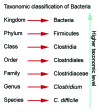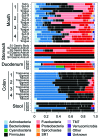The role of the gastrointestinal microbiome in Helicobacter pylori pathogenesis
- PMID: 23962822
- PMCID: PMC3928162
- DOI: 10.4161/gmic.26205
The role of the gastrointestinal microbiome in Helicobacter pylori pathogenesis
Abstract
The discovery of Helicobacter pylori overturned the conventional dogma that the stomach was a sterile organ and that pH values<4 were capable of sterilizing the stomach. H. pylori are an etiological agent associated with gastritis, hypochlorhydria, duodenal ulcers, and gastric cancer. It is now appreciated that the human stomach supports a bacterial community with possibly 100s of bacterial species that influence stomach homeostasis. Other bacteria colonizing the stomach may also influence H. pylori-associated gastric pathogenesis by creating reactive oxygen and nitrogen species and modulating inflammatory responses. In this review, we summarize the available literature concerning the gastric microbiota in humans, mice, and Mongolian gerbils. We also discuss the gastric perturbations, many involving H. pylori, that facilitate the colonization by bacteria from other compartments of the gastrointestinal tract, and identify risk factors known to affect gastric homeostasis that contribute to changes in the microbiota.
Keywords: Helicobacter pylori; bacterial colonization; cancer; gastric; hypochlorhydria; microbiota; stomach.
Figures





References
Publication types
MeSH terms
Substances
Grants and funding
LinkOut - more resources
Full Text Sources
Other Literature Sources
Medical
